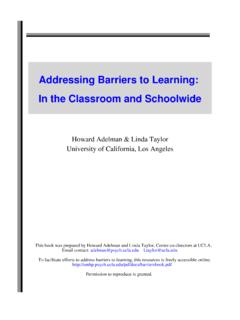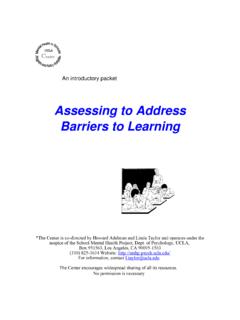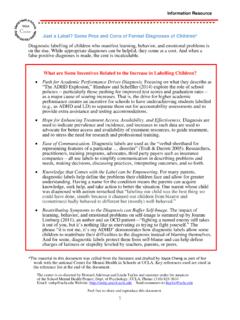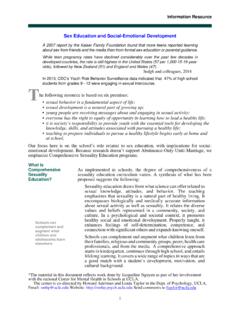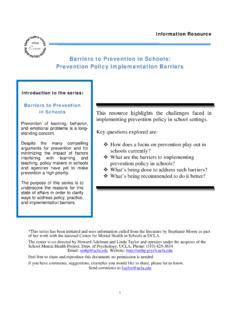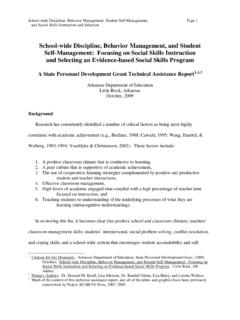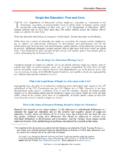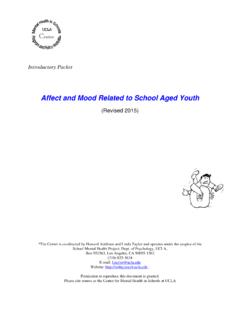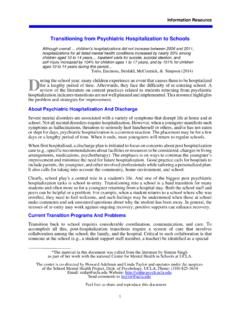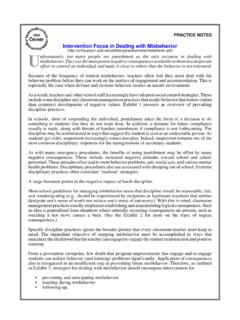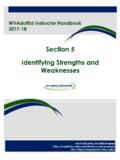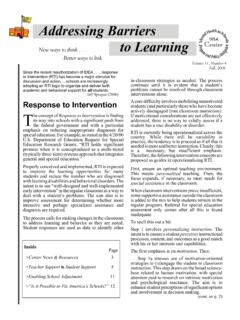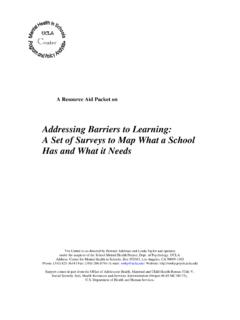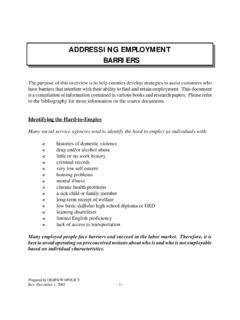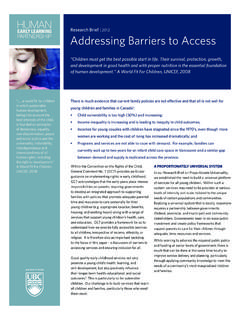Transcription of Enhancing Classroom Approaches for Addressing …
1 Improving Schools,Engaging StudentsContinuing Education Content Resource ModulesEnhancing Classroom Approaches for Addressing barriers to learning : Classroom -Focused EnablingThe center is co-directed by Howard Adelman and Linda Taylor and operates under the auspices of the School Mental Health Project, Dept. of Psychology, UCLA, Los Angeles, CA 90095-1563 Phone: (310) 825-3634. Permission to reproduce this document is granted. Please cite source as the Center for Mental Health in Schools at UCLA. Please reference this document as follows: Center for Mental Health in Schools.
2 (2008 revision). Enhancing Classroom Approaches for Addressing barriers to learning : Classroom -focusedenabling. Los Angeles, CA: at no cost from: needed, hard copies may be ordered from:Center for Mental Health in SchoolsUCLA Dept. of 951563 Los Angeles, CA 90095-1563 The Center encourages widespread sharing of all have come to believe that a great teacher is a great artist ..[Teaching may] even be the greatest of the arts since themedium is the human mind and SteinbeckTeaching is one of the most demanding professions.
3 It is particularly difficultin school settings where a large proportion of the student body are notperforming well. And, with efforts to raise standards and hold teachersaccountable, job stress is increasing. The problem is exacerbated by the growing teacher shortage. More and moreschools must employ novices, including individuals with little or no pre-service teacher preparation. And many of these newcomers are placed inschools where a large proportion of students come to class each day notparticularly enthusiastic about what they are expected to do and often withoutthe background of knowledge and skills to connect with the day s lessonplans.
4 Thus, the growing realities are that increasing numbers of teachers have not had the opportunity tolearn how to teach students who manifest commonplacelearning, behavior, and emotional problems most teachers must learn on-the-job how to teach such set of continuing education modules is designed as an aid for addressingthese realities. Module I provides a big picture context for understanding theproblems schools face and why every school must develop acomponent to address barriers to learning . Such a component isreferred to as an Enabling Component a component designedto enable learning by Addressing barriers to learning .
5 Asoutlined in Module I, this component encompasses sixprogrammatic areas. One of these areas is designated asClassroom-Focused Enabling which is designed to enhanceclassroom teachers capacity to address problems and fostersocial, emotional, intellectual, and behavioral Module II focuses on the nuts and bolts of Classroom -FocusedEnabling covering how teachers can transform the larger classby developing small learning groups and independent learningoptions in order to enhance student engagement, facilitatepositive learning , prevent problems, and provide specialassistance.
6 The practices discussed engender well-managedclassrooms and accomplish this in ways that minimize theoverreliance on social control strategies that have come tocharacterize too many teacher-student interactions. The aim, ofcourse, is to enhance student achievement and to do so in anenvironment that engenders a sense of community and mutualcaring in classrooms and throughout a school. Module III explores the role teachers can take in ensuring theirschools provide a context that supports and enhances classroomlearning. The set of modules represents our attempt to delineate a preservice/inservicepreparation content covering how regular classrooms and schools should bedesigned to ensure all students have appropriate opportunities to learneffectively.
7 This, of course, includes the many who manifest commonplacebehavior, learning , and emotional problems. Our Center has developed the setof modules with the intent of placing this content in the hands of schooladministrators, personnel preparation programs, teachers, school support staff,those who train pupil service personnel, community members, and others. Inaddition, we are making this content directly available to everyone as a formof independent continuing education. Those who draw on these contentresources for personnel preparation will, of course, need to adapt and embedthem into personalized and attractive instructional materials and is the case with the development of all our Center s products, many staffand graduate and undergraduate students have contributed to this work.
8 Ofparticular note is the many hours spent by Ashley Borders, Taraneh Roohi, andPerry Nelson, but many others over many years have shaped the contents. Thematerial represents a timely and progressive approach to the topic. At thesame time, the content, like the field itself, is seen as in a state of continuousevolution. Thus, we are extremely interested in receiving your feedback. In thecoming years, we expect to improve and refine the modules based on feedbackfrom the field. If you care to provide feedback at this stage, please do so bysending us your Adelman & Linda TaylorCenter Co-Directorsiii To Self-Study Users of this Work:The material in this continuing education document is designed as an evolving setof modules and units.
9 The material can be read and taught in a straight forwardsequence, or one or more parts can be combined into a personalized course. Theintent is to encourage learners to approach the material as they would use anInternet website ( , exploring specific topics of immediate interest and thengoing over the rest in any order that feels comfortable). The first module is meantto start you off with a big picture framework for understanding barriers to learningand how school reforms need to expand in order to effectively address suchbarriers.
10 This is essential if all youngsters are to have an equal opportunity tosucceed at school. Each of the units in the second module focus on classroompractices. Finally. the third module explores the roles teachers need to play inensuring their school develops a comprehensive approach to Addressing barriersto learning . To the LearnerBeginning each section are specific objectives meant to help guide reading andreview. Interspersed throughout each section are boxed exhibits designed tohelp you think a bit more about specific ideas and practices.
